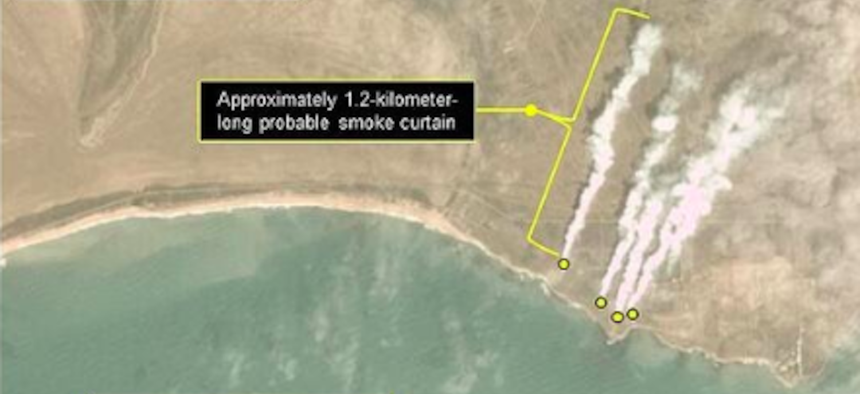
Satellite imagery shows Russian use of smoke operations in Crimea, part of an April 15 exercise. Orbital Insight / PLANET / Allsource Analysis
Was Russia’s April Exercise a Practice Run for a Ukraine Invasion?
The use of smoke operations and a large troop presence in Crimea suggests that Russia was telegraphing its ability to launch a major assault on Ukraine.
Moscow's illegal annexation of Ukraine’s Crimean peninsula in 2014 isolated Russia internationally, but also secured a foothold that could be used to attack the rest of Ukraine. New analysis shows that a recent exercise on the peninsula may have been practice for a wider invasion.
Data analysis firm Orbital Insight used its GO platform to analyze satellite imagery, cell phone pings, and other pieces of open-source information from Crimea during the exercise, which ran from mid-March until May.
At the time, the buildup of more than 100,000 troops sparked concern that Russia was training to expand military operations into Ukraine, said Dan Soller, the senior advisor on national security programs at Orbital Insight.
In addition to previously revealed satellite imagery showing a large buildup of aircraft on the airfield near Novofedorivka (on the western coast), the Orbital Insight analysis (with images from PLANET and partner AllSource Analysis) shows trucks near the Opuk training ground practicing to use smoke to obscure troop movements.
“When you have this many trucks out there doing smoke operations, that’s pretty significant because that’s a costly exercise to do,” said Soller, a former Army and NGA intelligence officer. “Smoke operations in general are used for two things: One is offensive operations, and one is retrograde. As you can imagine, highly unlikely Russians were training to retrograde out of Crimea.”
“With 100,000 Russian troops in the area during this exercise...yes, this was a demonstration to show that they were training to conduct operations into Ukraine if necessary,” he said.

A slide courtesty of Orbital Insight showing new analysis of Russian smoke operations on Crimea, April 15, 2021.
But Middlebury researcher Jeff Lewis said, “Smoke operations are pretty widespread and the Russian media has openly reported on them in the past...I am not sure I would go so far as to say that smoke operations are inherently offensive.”
The White House this week pledged to increase aid to Ukraine by $60 million, following a visit to the Washington by Ukrainian President Volodymyr Zelenskyy.
“The United States supports Ukraine’s efforts to use the Crimea platform to focus international attention and action on the humanitarian and security costs of Russia’s occupation of Crimea, with the aim of peacefully restoring Ukraine’s control over this territory in accordance with international law,” the White House and Ukrainian government said in joint statement on Wednesday. “Together, we call on Russia to recommit to the ceasefire in eastern Ukraine and engage genuinely in conflict resolution efforts to end the war.”
Tomasz Szatkowski, Poland’s ambassador to NATO, urged vigilance on Thursday.
“Russians have showcased their readiness to deploy very significant capabilities to Crimea,” Szatkowski said in conversation with Defense One during the European Cybersecurity Forum in Poland. “The situation in Ukraine has not been going the way [Russia] want[s] it to go. They were counting in recent years on some sort of settlement… Both the previous government and the current one have resisted such pressure.”
Russia, he said, “may feel emboldened about a number of developments in the world,” such as the psychological impact of the fall of Kabul in Afghanistan to Taliban forces, which forced a chaotic evacuation of U.S. forces, civilians, and allies.
“Russians may want to build on that psychological impact,” he said.
Szatkowski pointed to Russia’s upcoming Zapad exercise in Belarus as particularly concerning. But, he said, Russia’s willingness to demonstrate large invasion capabilities doesn’t necessarily foretell a growing willingness to use them.




